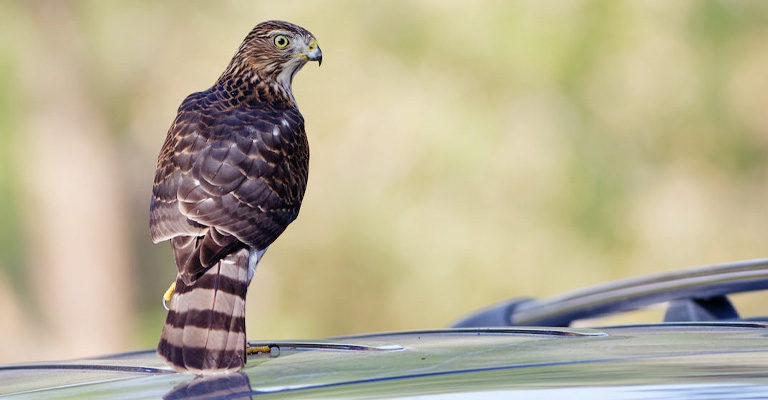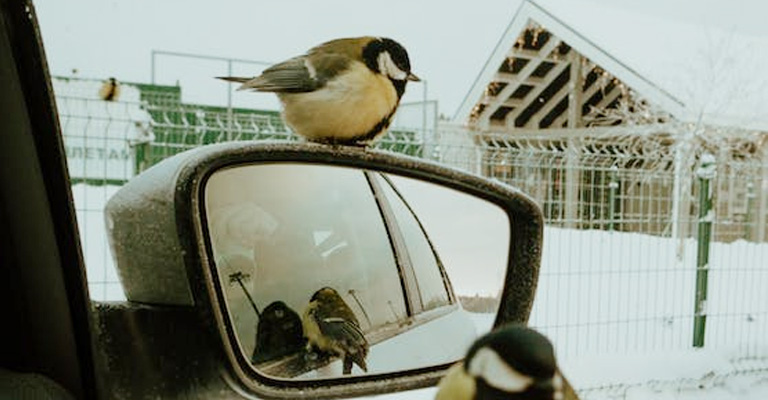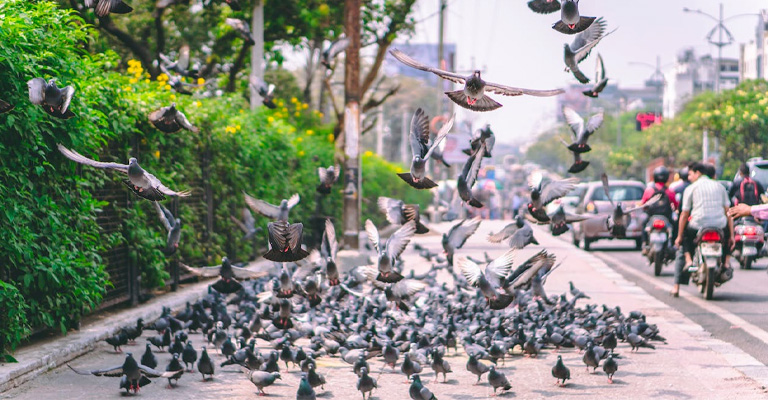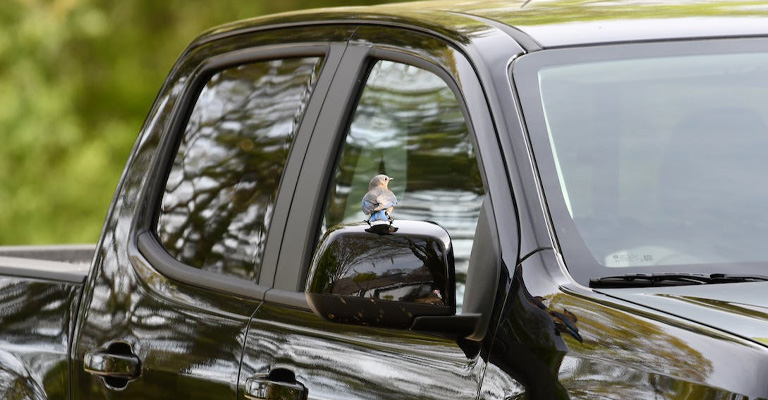In the bustling world of urban landscapes, one cannot help but marvel at the seemingly innate ability of birds to navigate through traffic unscathed.
Their graceful flight and uncanny knack for avoiding oncoming vehicles have left many pondering the secret behind their survival.
How do birds always seem to know how to get out of the way of cars? This article delves into the fascinating realm of avian behavior, shedding light on the mechanisms that enable birds to evade cars with remarkable precision.
Birds, with their keen senses and evolutionary adaptations, have developed a repertoire of strategies to avoid collisions with vehicles.
From their exceptional visual acuity and swift reaction times to their ability to perceive sound and interpret environmental cues, these avian marvels possess a remarkable set of skills that aid their survival in the face of modern-day traffic challenges.

How do Birds Always Seem to Know How to Get out of the Way of Cars?
Birds have an incredible ability to avoid collisions with cars, which can be attributed to their natural instincts and adaptive behaviors. Let’s explore this topic in more detail.
Visual Acuity
Birds have excellent eyesight, often far superior to humans. Their eyes are adapted to detect motion and perceive objects at a distance. This heightened visual acuity allows them to spot oncoming vehicles and react quickly.
Flight Adaptations
Birds are highly maneuverable in flight, thanks to their wings and feathers. They can change direction rapidly, adjust their altitude, and even hover in place.
These flight adaptations enable them to navigate through complex environments, including busy roads, with relative ease.
Sensory Perception
Birds possess a range of sensory abilities that aid in their avoidance of cars. For instance, they can hear the sound of approaching vehicles from a distance, allowing them to react promptly.
Additionally, birds have a keen sense of spatial awareness, which helps them judge the speed and trajectory of oncoming cars.
Flock Behavior
Many bird species exhibit flocking behavior, where they fly together in large groups. Flocking provides safety in numbers and enhances their collective ability to detect and respond to potential threats, such as cars.
Birds within a flock can communicate and share information about potential dangers, increasing their chances of avoiding collisions.
Learning from Experience

Birds learn from their own experiences and observations. Over time, they become familiar with the patterns and behaviors of cars on roads.
They learn to associate the noise, movement, and visual cues of vehicles with potential danger, allowing them to react accordingly.
Instinctual Responses
Birds have innate instincts that help them survive in their environment. These instincts include an inherent fear of predators, which can extend to perceiving cars as potential threats.
Their instinctual responses prompt them to take evasive action when they sense danger, such as flying away or seeking cover.
Habitat Adaptation
Birds that inhabit urban areas have adapted to the presence of cars and other human activities. They have learned to navigate through traffic and find safe perches or nesting sites away from busy roads. This adaptation reduces their exposure to potential collisions.
Evolutionary Factors
Birds have evolved over millions of years, adapting to various environmental challenges. Those that were better able to avoid collisions with fast-moving objects, such as predators or flying debris, had a higher chance of survival and passing on their genes.
This natural selection process has likely contributed to the development of their avoidance behaviors.
It’s important to note that while birds generally have a good track record of avoiding cars, collisions can still occur. Factors such as vehicle speed, bird behavior, and environmental conditions can influence the outcome.
Therefore, it’s crucial for drivers to remain vigilant and take precautions to avoid harming birds and other wildlife on the road.
Why Do Sometimes Birds Fly Close to Cars?

While birds generally have the ability to avoid cars, there are instances where they may fly close to vehicles. Several factors can contribute to this behavior:
Attracted to Roadside Food
Birds, especially scavengers like crows or seagulls, may be drawn to roadsides where they can find food scraps or insects attracted to the road. This can lead them to fly close to cars in search of a meal.
Roadside Perching Spots
Some birds, such as sparrows or pigeons, may use cars as perching spots. The warmth radiated by a parked car’s engine or the shelter provided by a stationary vehicle can be appealing to birds, especially during colder weather. This can result in them flying close to cars or even landing on them.
Chasing Insects
Birds that feed on insects, like swallows or flycatchers, may fly close to cars that disturb insects as they drive. The movement and disturbance caused by vehicles can create an opportunity for birds to catch insects in flight.
Nesting or Roosting Sites
Certain bird species may choose to build nests or roost in trees or structures near roads. This proximity to traffic can lead to birds flying close to cars as they travel to and from their nests or roosting sites.
Disorientation or Confusion
In some cases, birds may become disoriented or confused by the presence of cars. The noise, movement, and visual stimuli associated with traffic can disrupt their natural navigation abilities, causing them to fly erratically or close to vehicles.
Young or Inexperienced Birds
Young or inexperienced birds may not have fully developed their avoidance behaviors or learned to recognize the dangers posed by cars. As a result, they may inadvertently fly close to vehicles due to their lack of experience or understanding.
It’s important for drivers to be cautious and aware of birds flying close to their vehicles. Slowing down, maintaining a steady speed, and avoiding sudden movements can help minimize the risk of collisions.
Overall, while birds generally have the ability to avoid cars, various factors can influence their behavior and lead them to fly close to vehicles. Understanding these factors can help promote coexistence and reduce the potential for accidents involving birds and cars.
What Does It Mean If A Bird Flies On The Inside Of Your Car Window?

Birds flying inside a car can be interpreted in various ways, and people often attribute different meanings to such occurrences based on their cultural beliefs, superstitions, or personal experiences.
Here are some amazing meanings:
Unexpected Visitor
A bird flying into your car might be seen as an unexpected and unique visitor. This event could symbolize spontaneity or a surprise encounter that brings a touch of novelty to your day.
It might remind you to be open to unexpected opportunities and to embrace the unpredictability of life.
Symbol of Freedom
Birds are often associated with freedom due to their ability to soar through the sky. When a bird flies inside your car, you might interpret it as a reminder to break free from limitations or constraints that have been holding you back.
This could be a sign to take a step outside your comfort zone and explore new horizons.
Message from Nature
Some believe that animals, including birds, can carry messages from the natural world.
Seeing a bird fly inside your car might be viewed as a message from Nature, suggesting that you pay attention to the world around you and stay connected to the environment. It might be a gentle nudge to be more attuned to your surroundings.
Omen or Sign
In many cultures, birds are considered messengers or omens. If a bird enters your car, it could be interpreted as a sign of upcoming changes or events.
The specific type of bird and its behavior could be analyzed for clues about what’s ahead. Some may interpret it as a positive sign, while others might view it as a warning.
Spiritual or Symbolic Encounter
For some individuals, encountering a bird in an unexpected place, like a car, could be seen as a symbolic or spiritual experience.
It might evoke feelings of connection to the universe or a higher power. This encounter could be a reminder to stay in tune with your spiritual side and seek deeper meaning in everyday occurrences.
Breaking Routine
Birds flying inside your car disrupt the routine and expected course of events. This occurrence might serve as a reminder that it’s important to break free from the monotony of daily life and embrace moments of spontaneity.
It encourages you to find joy in the unexpected and to appreciate the beauty of life’s surprises.
Bringing Nature Closer
Modern life often keeps us detached from the natural world. When a bird flies into your car, it provides a unique opportunity to connect with wildlife up close.
This experience might prompt you to reflect on the importance of coexisting with Nature and preserving the planet’s biodiversity.
In the end, the interpretation of a bird flying inside your car is subjective and varies from person to person.
It’s essential to consider your personal beliefs, cultural background, and feelings when assigning meaning to such an event.
FAQs
Certain bird species are more prone to colliding with electric wires due to their flight patterns or nesting behaviors.
For example, large raptors like eagles or hawks may accidentally collide with power lines while hunting or during territorial disputes.
Yes, electric wires can pose a threat of electrocution to birds. If a bird comes into contact with both a live wire and a grounded object simultaneously, it can create a path for electricity to flow through the bird’s body, resulting in electrocution.
Power companies employ various strategies to address the issue of bird collisions with electric wires.
These include installing bird diverters, which are visual markers or devices attached to the wires to increase their visibility to birds.
Bird collisions with electric wires can sometimes cause power outages or damage to the infrastructure.
When a bird makes contact with a live wire, it can create a short circuit, leading to disruptions in the electrical system.
Individuals can contribute to reducing bird collisions with electric wires by supporting bird-friendly power infrastructure initiatives and advocate for the use of bird diverters and other measures to increase wire visibility.
Final Words
The ability of birds to consistently evade oncoming cars is a testament to their remarkable adaptation and survival instincts.
Through a combination of sensory perception, cognitive abilities, and learned behaviors, these avian creatures have honed their skills to navigate the ever-changing urban landscape.
Understanding the mechanisms behind their evasive maneuvers not only deepens our appreciation for the natural world but also highlights the importance of coexistence between humans and wildlife.
As we continue to expand our cities and road networks, it is crucial to consider the impact on our feathered friends.
Implementing measures such as wildlife-friendly infrastructure, reduced speed limits in sensitive areas, and public awareness campaigns can help mitigate the risks faced by birds and other wildlife.
So, the next time you witness a bird gracefully darting through traffic unharmed, take a moment to marvel at their innate abilities and the wonders of nature.